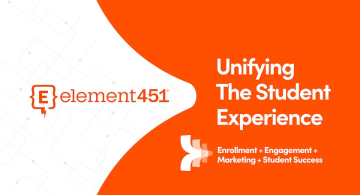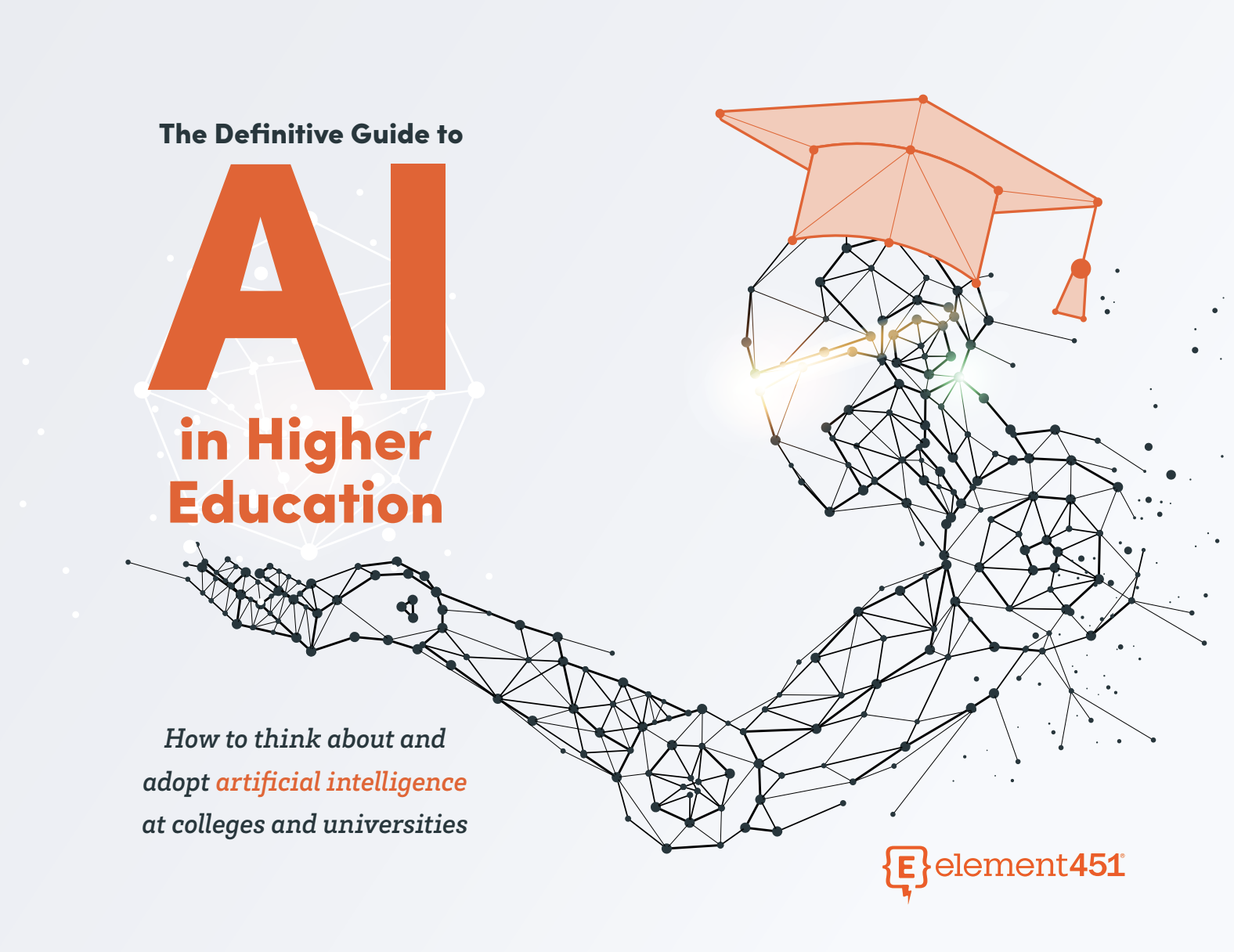How Higher Ed Software Helps Break Admissions Barriers
by Sirley Carballo · Updated Jun 16, 2022
What do you need to improve higher education admissions? Well, more applications and a better retention rate is a good starting point. But that’s easier said than done, especially in today’s climate.

Prospective and current student expectations are higher than ever and institutions need to be searching for ways to stay ahead of the curve and add value during the selection process.
So is your institution moving with the times, or slowly being left behind by more innovative higher ed institutions? In this post, learn how to increase enrollment using higher education enrollment software and discover our 6 tips to choosing the right one for you.

Guide to Choosing a CRM for Higher Ed
Pick a platform that meets your strategic and operational needs
Download the White Paper
Modernize student recruitment with admissions and enrollment management software for higher education
For decades, recruitment has been driven by the institution. But in today’s student-driven world, this is no longer enough. Students expect a personalized approach that empowers them with the information they need, when they need it. Developing your strategy to get there is a daunting challenge, especially when transitioning from a cookie-cooker approach to individualized experiences.
Applicants have high expectations, and you need to anticipate their needs, so you're ready to give them what they want, when they want it, and in the format they prefer. Their experience determines whether they will keep you on their maybe list or move you to the dreaded no's.
But a student-centered transformation requires data - the kind that comes from analyzing the critical touchpoints throughout every student's journey, including their application, emails they've opened, links they've clicked, and everything in between. That’s why it’s critical to have higher ed software that centralizes all enrollment marketing and admissions activities in one place. The information that’s collected helps to make continuous and informed decisions about the student’s admissions experience, reducing barriers to enrollment.
What is enrollment management software and why does it matter for higher education institutions?
Simply put, enrollment management software acts as a customer relationship management (CRM) system that facilitates engagement, efficiency, and transparency across organizations.
CRMs help automate the enrollment process for higher education institutions and personalize crucial touch-points throughout the student lifecycle, from application to graduation and beyond. You could call it the swiss army knife of higher education recruitment.
For students, it provides a smooth, efficient and responsive enrollment process. Applicants expect timely, personalized, and easy interactions, similar to what they’re used to shopping online, watching entertainment, and using social media platforms. A poor experience can lead to students choosing other schools over you.
The benefits of using an online enrollment system and how they break your barriers to admission:
Instant and Consistent Communication
Nobody likes to be left in the lurch, and communication is critical for building and maintaining relationships. If you leave a candidate waiting too long to hear from you, they may apply to other schools, adding to the reasons you don’t reach your enrollment goals. Instant and consistent communication keeps students engaged with your school, placing you top of mind, which has never been more important for admitted yield.
Whether you’re receiving messages from prospective students that need prompt responses or you’re sending digital acceptance letters, event invites, or financial aid information, you can manage it all (and automate much of it) from your enrollment system.
Personalized Student-Driven Experiences
To improve enrollment numbers, you need to remove as much friction and uncertainty as possible from the application and enrollment process. Show students and families that you understand and prioritize their needs by employing personalized campaigns.
Every touchpoint is an opportunity to build a relationship, and that’s just as important for those who decide not to attend your institution as those who do. Everyone you come into contact with becomes your brand messenger. Applicants will be asked about their experience with you by their friends, family, their current school, etc.
You want to make sure it's a positive experience because the average American tells 15 people when they’ve had a poor customer service experience. Those 15 people then pass on what they’ve been told, and the snowball effect rolls on. Online enrollment software helps you transition to a student-driven recruiting approach that provides a personal and valuable experience at scale.
Full Student Lifecycle Support
As you well know, the job isn't finished once a student enrolls. Therefore, you need to support them through their journey until they graduate with as much attention as you did when they applied.
This is important for many reasons, but the most important being retention and reputation. Retention becomes more achievable when you have the right tools to effectively communicate with and support your students. With this, you build stronger relationships that boost your institution's reputation.
Organization
Not only is a CRM efficient for the enrollment team, but it also improves efficiency and communication across other departments. Information is housed in one central place so everyone who interacts with a student can view and manage records.
Many CRMs also have automation tools and the ability to integrate other business-related apps to eliminate time-consuming and repetitive tasks allowing you to focus on enhancing the student experience.
The must-have features you should look for in an enrollment management system
- Student Record Management - Keeping localized student information within departments, or even paper records, is not only old school; but it’s also inefficient and impedes strong student relationships.
- Eliminating data silos by tracking important information within a centralized student record means that any staff member can access that information with the click of a button, saving both parties time and stress.
- Easy to use system - While this may seem too obvious to include, you don't want to sign up for a new system that you don't have the skills to use in-house. While developers will always try to lessen the learning curve with their systems, make sure you consider any team members who aren't as tech-savvy.
- Multichannel communication - Everyone has a preferred method of communication, so you need the ability to cater to students' expectations. Your enrollment management software should allow you to easily communicate across text, email, web, and more so students can engage in their chosen way. This also increases your visibility, keeping you top of mind.
- Insights and analytics - Without data, it can be hard to track the ebb and flow of enrollment each year which can affect critical campus decision making. Stop the guesswork and use real-time data analysis to maximize engagement and enrollment. See how prospects engage with your messaging, what motivates their decisions, and which campaigns are the most effective.
As mentioned earlier, you need to take into account your teams' skills, so we recommend finding a system that delivers one-click reports that require minimal setup.
6 Tips on how to choose the best CRM for college admissions:
1. Clearly define the admissions goals that your CRM system will help you accomplish
This is an obvious but vital first step that can make or break the success you see with your CRM system. Your goals need to dive deeper than “improve enrollment by x%”. That is your final destination, and you need to map out your journey there.
Campus leaders should ask what they need to improve, what their students need, and what their students respond well to, so they can do more of it. After digesting this blog, you’ll better understand how a CRM system can move you towards your goals.
2. Consider implementation time & ease of use
Any software you roll out should be easy to learn. The simplest and quickest platforms to implement are those that have features such as:
- No coding requirements (drag and drop builders)
- Live support and/or support teams
- Marketing automation
- Prebuilt campaigns
3. Platform capabilities and function: What system will give you everything you need in one place?
Many CRM systems have similar features and capabilities. Thinking back to our first tip of defining goals, you need to know how you want to leverage the platform and how far you’d like to push your digital transformation.
Every institution is different, so what works well for another might not for you. Before you get neck-deep in research, check out our blog, CRM for Higher Education: 12 Best Options to Consider, to shorten your search and eliminate any headaches.
4. How will your CRM deliver personalized enrollment experiences that stand out and simplify student enrollment?
Standing out from other schools doesn't need to be complicated in strategy or execution. It all comes back to creating a student-driven, personalized approach. Your CRM system can help you do this in two ways:
1. Tracking - Because it stores all your prospective students’ interactions, you can learn what’s most effective towards particular goals along the enrollment journey and improve the process. For example, you might have a trigger set up in the CRM system to send an email campaign based on the topic of a page a student visited multiple times. Tracking data can tell you if that approach is bringing in more applicants.
2. Marketing Automation - Adding someone's name at the beginning of an email isn't adequate personalization. How do you make something personal without sacrificing efficiency? Segmenting your audiences to deliver truly personalized campaigns is a powerful tactic, but some systems allow you to go one step further.
For example, Element451 has advanced personalization tools that allow you to customize content down to the sentence level depending on what stage of the funnel they're in, what major they're interested in, their location, and much more.
5. Application integration: Linking tools should be quick and easy
It’s all well and good signing up for a fancy new piece of software, but does it work with your other tools? Unfortunately, as impressive as high-tech enrollment software can be, it can’t replace your entire tech stack, so you’ll need to integrate other business-related apps.
Ensure that a potential new system supports and complements the tools (e.g. payment processing, Zoom, video messaging recording) that you won’t replace before committing to any costly contracts. These integrations can either be done directly through the platform or using a third-party tool such as Zapier.
6. User experience: Your system revolves around your students from start to finish
The number of college applications submitted or partially completed via a mobile device has increased by over 61% in recent years. To keep up with the competition, you must meet your prospective students where they are - with a seamless digital experience they expect from the companies and organizations they interact with.
To access the internet, 28% of 18-29-year-olds rely on smartphones. That means you could be blocking over a quarter of prospective students from engaging with your institution if you aren't optimized for mobile users.
Being optimized means that your system should be designed for mobile from the ground up. It shouldn’t be an afterthought that results in some things working just OK or not at all on a tablet or phone. Selecting enrollment software that prioritizes mobile-friendliness makes it simple for you to deliver a consistently amazing mobile experience.
Winning institutions will prioritize the student experience
The student experience should be at the heart of your recruitment process. Online enrollment management systems help you to provide quality experiences through personalized communication and better customer service with centralized information. With this software, higher educational institutions can also make informed campus decisions using real-time data.
This all amounts to empowering students and putting them at the center of the enrollment process to ultimately break down the barriers for students enrolling in your school.

About Element451
Boost enrollment, improve engagement, and support students with an AI workforce built for higher ed. Element451 makes personalization scalable and success repeatable.
Categories
New Blog Posts

The Definitive Guide
AI in Higher Education
Bridge the gap between the latest tech advancements and your institution's success.
Useful Links

Talk With Us
Element451 is the only AI Workforce Platform for higher education. Our friendly experts are here to help you explore how Element451 can improve outcomes for your school.
Get a Demo








